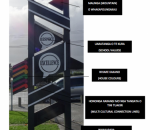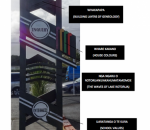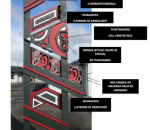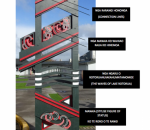WHAKAMARAMA (click for PDF version)
WHAKAMARAMA O NGA POU O TE HONO
MAIN FEATURES:
The main features in terms of the panel shape and form of Nga pou (Posts) TE HONO is based on the
Powhiri (Formal Welcoming Process). It is important when performing the Powhiri that Manuhiri
(Visitors) feel connected to the Tangata Whenua (People of this Land), the Whare Kura (School) and
the Whenua (Land). This Hononga Rarangi (Connection line) is clearly seen in the Powhiri through
the exchanges of the Karanga (Calling) and Whaikorero (Formal Speeches). When visitors enter for
the first time on this Papa Whenua (Ground) it is by walking a line that is governed and created by
the local protocols of the Hau Kainga (Hosting People). This eventually leads to the seating area of
the formal speeches. The Whaikorero creates the next line whilst performing speeches opposite
each other, and as a whole these analogy lines of connection are (Whiri) woven and plaited as one.
This interwoven connection is the intention of the Powhiri.
Performing the Powhiri may vary from performing certain stages to completing all stages depending
on Tikanga (Protocol) but the intention never changes.
The main features in terms of the panel shape and form are also suggestive of a Waharoa (Entrance
way), whereby some panels are overlapping and angled like Maihi (Barge Boards) that bridge the
side posts together as a whole. This is to pay homage to the entrance way in its traditional form
acknowledging the past and present whilst looking to the future.
DESIGNS, PATTERNS;
The designs and patterns on the outside (facing road) are based from the historic brief given by the
kura about the land and its occupation of this area by the eponymous ancestors throughout
different periods of time. The Manaia that represent eponymous ancestors should be read from top
to bottom in accordance to time period of earliest to latest settlement of Puketawhero. These
ancestor designs are the (Kaitiaki) guardians and are placed facing the outside as protectors and
guardians of this school.
The design and patterns (Ki roto I te Ao) on the inside represent (Nga Tamariki, Nga Matua, Nga
Kaiako me te Ahurei o te kura) the children, parents, teachers and the culture of this school. The
inside and outside patterns and designs as a whole re affirms the acknowledgement of our past
present and future.
COLOURS:
The colours of red,green and white on the outside not only support the historic brief through the
land Puketawhero (Hill painted Red), Whakapoungakau and our ancestors of whom many of their
decendants are here today but to the Waharoa at the office which refers to the Kauwae Runga (All
things Celestial, Heavenly) and the quest for the baskets of knowledge situated in the 12th heaven
(TE TOI O NGA RANGI).
Repeated references of the land through the green colours can be seen on the inside. The black and
white refer to the multi cultures of today and the white again highlights the purity of the school
values. The purple,orange,light green and yellow colours represent the house groups.
Nga mihi nui kia koutou tena koutou, Na Colin Tihi.





